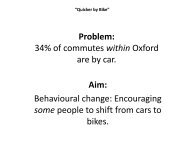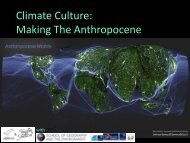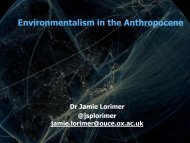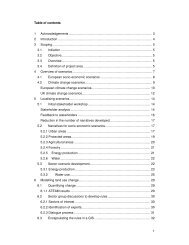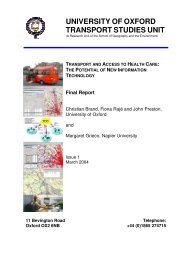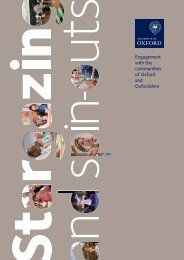Peak_Stuff_17.10.11 - Chris Goodall
Create successful ePaper yourself
Turn your PDF publications into a flip-book with our unique Google optimized e-Paper software.
‘<strong>Peak</strong> <strong>Stuff</strong>’<br />
Did the UK reach a maximum use of material<br />
resources in the early part of the last decade? 1<br />
A research paper by <strong>Chris</strong> <strong>Goodall</strong><br />
chris@carboncommentary.com<br />
+44 (0) 7767 386696<br />
13 October 2011<br />
Empirical evidence presented in this paper supports a hypothesis that the UK began to reduce its<br />
consumption of physical resources in the early years of the last decade, well before the economic<br />
slowdown that started in 2008. This conclusion applies to a wide variety of different physical goods,<br />
for example water, building materials and paper and includes the impact of items imported from<br />
overseas. Both the weight of goods entering the economy and the amounts finally ending up as<br />
waste probably began to fall from sometime between 2001 and 2003. 2 Summary data is available on<br />
the last page of this document.<br />
If correct, this finding is important. It suggests that economic growth in a mature economy does not<br />
necessarily increase the pressure on the world’s reserves of natural resources and on its physical<br />
environment. An advanced country may be able to decouple economic growth and increasing<br />
volumes of material goods consumed. A sustainable economy does not necessarily have to be a nogrowth<br />
economy.<br />
The problem<br />
Is continued economic growth possible without increasing the strains on the global environment? This<br />
question has been debated for several decades. Pessimists have pointed to the continuing increase in the<br />
world’s use of physical resources, such as fossil fuels and fresh water, as the size of the global economy<br />
grows. They believe that the world needs to recognise that growth, at least as conventionally defined by<br />
economists, necessarily imposes greater and greater pressures on the world’s ecology. 3 The potential<br />
problems are numerous; more burning of fossil fuels means increased risk of dangerous climate change,<br />
the strains on fresh water supplies will grow, fertiliser use will cause increased marine pollution and the<br />
extraction of ores and minerals will cause major environmental problems on land.<br />
1 Mark Lynas and Mike Berners-Lee provided extremely helpful comments on a first draft of this paper. Duncan<br />
Clark gave very detailed feedback indeed. I am very grateful to them all. Errors remain mine. Any further<br />
comments on this article would be very much appreciated. <br />
2<br />
The decline between 2003 and 2007 occurred at the same time as UK population rose by about 2.4%. Source:<br />
ONS population estimates.<br />
3<br />
In his powerful book Prosperity Without Growth, Tim Jackson makes the pessimistic case particularly well in the<br />
chapter entitled The Myth of Decoupling.
More sanguine commentators have hypothesised that beyond a certain point economic growth requires<br />
smaller amounts of material input: richer societies should be able to impose a lesser strain on the global<br />
ecosystem as they become more efficient in their use of fuels, minerals and the biological materials<br />
grown on the earth’s surface. Taken in the round, technological change tends to reduce the weight of<br />
raw materials needed to provide a useful good or service. The optimists claim that continued economic<br />
growth is wholly compatible with ecological stability because richer societies will actually need fewer<br />
material inputs and will switch to economic activities based on the use of information and the provision<br />
of services. The rapid economic growth of China and other transition economies is causing severe<br />
environmental stresses on land, water and in the atmosphere. But once these countries have reached a<br />
certain level of development, the optimists say, their impact on the world’s ecology will tend to<br />
diminish. 4 They argue therefore that faster growth in China is to be welcomed.<br />
There are few more important issues to resolve than whether continued economic growth and<br />
ecological stability are compatible. Empirical investigations into this topic have tended to produce<br />
inconclusive results that suggest that rich economies have, at best, partially decoupled economic growth<br />
from increasing use of material resources. The volume of physical inputs used by the economy has<br />
tended to rise, but at a much slower rate than economic growth. In other words, there has been some<br />
gain in efficiency, but not enough to reduce the absolute level of resources used. A country might, for<br />
example, grow at an average of 2% per year but the fossil fuels necessary to sustain the economy might<br />
typically only grow at 1%. This is usually called ‘relative decoupling’. The evidence presented here is<br />
compatible with a much stronger hypothesis that the UK may have begun a process of absolute<br />
decoupling in which resource use falls even in periods of growth. In times of recession, the decline will<br />
be faster still.<br />
The simple model of an economy expressed in physical terms<br />
Government statisticians regularly measure the physical resources used by a country. In the UK, these<br />
measurements produce a series called the Material Flow Accounts. First, the statisticians estimate the<br />
three main sources of material resources used to sustain the economy: biomass, minerals and fossil<br />
fuels.<br />
• Biomass The economy produces agricultural harvest that provides food to the population and<br />
fibres for textiles. Second, animals graze the fields, eating grass and other biomass that they<br />
turn into meat and other useful material. Third, timber is collected for fuel and for other uses.<br />
Lastly, fish is collected from the seas and rivers for food.<br />
• Minerals Ores are used for processing into metals and other substances. Clay makes bricks and<br />
other building materials as well as pottery and raw materials for paper and other products.<br />
Sand and gravel, stone and other minerals are used for construction of buildings and road.<br />
• Fossil fuels Fossil fuels are used for burning for heat and electricity as well as providing the<br />
raw materials for plastics and chemical products.<br />
Each of these three types of input is processed to deliver value to the human population and eventually<br />
becomes waste.<br />
4<br />
The hypothesis that the environmental impact of a country rises sharply as its national income increases but then<br />
tends to fall once a high GDP has been reached is often called ‘the environmental Kuznets curve’ after the<br />
economist Simon Kuznets who pioneered national economic accounting.<br />
2
Biomass<br />
Most biomass employed as food is returned to the earth’s surface. Biomass, both fish and land harvest, is<br />
eaten and excreted by animals and humans. Human waste in advanced societies generally ends up as<br />
sewage sludge, which is typically returned to the soil by application as a fertiliser. Waste food in<br />
advanced economies is usually collected and put in landfill (where it will usually turn into methane) or<br />
it is composted.<br />
Biomass used for fibres and textiles, such as wool, linen or cotton, will generally become municipal<br />
waste. (Some clothing is reused, but it still eventually ends up in landfill or compost).<br />
Excluding small amounts of ash, timber that is used for fuel returns to the atmosphere, principally as<br />
CO2. More UK timber is turned into paper and other products based on pulp. These products will<br />
generally end up in municipal waste. Other wood is used in construction, where it will often be stored<br />
for a long period, perhaps hundreds of years, but will eventually rot or be burned and become carbon<br />
dioxide.<br />
Minerals<br />
Minerals are refined to make metals and other products. The waste from mining and industrial<br />
processing used to be placed in landfill but increasing amounts are now reused. The major endproducts,<br />
such as steel and aluminium, can be indefinitely recycled although a large portion is still<br />
added to waste depositories. Stone, sand and gravel are employed in construction. Eventually, most<br />
building materials end up as inert waste, and are recycled or put in landfill, though the delay can be<br />
hundreds of years.<br />
Fossil fuels<br />
Fossil fuels will generally be burnt creating carbon dioxide, which is added to the atmosphere but may<br />
in future be stored underground as a result of carbon capture.<br />
So the human use of fuels, minerals and biomass to sustain our living standards result in some clear<br />
outcomes. Biomass will generally be returned to the soil or added to the atmosphere in the form of CO2,<br />
with some small portion ending up as municipal waste. Mineral ores tailings will be returned to the<br />
ground while the useful portion of the ore – such as a metal – will either be in a recycling loop or be<br />
disposed of as waste. Fossil fuels end up in the atmosphere. The simplicity of these routes helps us<br />
assess whether the impact of a modern economy on the global sea, land and atmosphere is rising or<br />
falling. Everything we use has to come from one of the three groups – biomass, minerals and fossil fuels<br />
– and has to be eventually added to the atmosphere, be returned to the ground, or live on in endless<br />
recycling loops. If we can measure the weight of what we extract from the ground and what we<br />
eventually put back as waste then we can estimate whether the necessary impact of economic growth is<br />
to impose extra strains on the earth’s resources.<br />
The UK’s material flow accounts<br />
These accounts are prepared to the high standards of the UK’s Office of National Statistics (ONS). They<br />
are necessarily imprecise but provide a good guide to the weight of resources used by the British<br />
economy.<br />
3
These accounts offer three principal indices.<br />
• Total Domestic Extraction (TDE). This measures the weight of biomass, minerals and fossil<br />
fuels taken from the ground in the UK.<br />
• The UK imports biomass, minerals and fossil fuels. The second index is called Direct Material<br />
Consumption (DMR), which adds imports and subtracts exports from Total Domestic<br />
Extraction.<br />
• Goods imported into the UK are made using resources of biomass, minerals and fossil fuels in<br />
their country of origin. The third measure includes estimates of the materials employed in other<br />
countries to make UK imports. This is called Total Material Requirement (TMR).<br />
These three figures represent estimates of the total inputs into the UK’s material standard of living. The<br />
important point is this: if economic growth implies increased use of physical resources then we should<br />
see increased material inputs when the economy is growing, as it did with remarkable constancy during<br />
the fifteen years from 1993 to 2007.<br />
Total Domestic Extraction, the measure of the weight of resources of biomass, minerals and fossil fuels<br />
extracted in the UK, peaked in 1988 and by 2007, the year of the end of the boom, had fallen to 74% of<br />
its 1988 figure. The obvious explanation is that the UK now imports a larger fraction of its total<br />
consumption of physical goods, and that extraction elsewhere in the world is increasing as a result. But<br />
the two other measures – Direct Material Consumption and Total Material Requirement – may also<br />
have peaked before growth was interrupted in 2007 and they incorporate estimates of resource use in<br />
foreign countries to make the UK’s imports. Direct Material Consumption (DMC which is Total<br />
Domestic Extraction less exports plus imports) peaked in 1973 at 838 million tonnes and slid erratically<br />
to 700 million tonnes in 2001. Total Material Requirement (TMR), which includes estimates of the<br />
resources used outside the UK to make goods that are then imported into this country, reached an<br />
absolute peak of 2174 million tonnes in 2001. It is not entirely clear that the trend is strongly<br />
downwards from this point but by 2007, this figure was 2091 million tonnes.<br />
By 2007, the DMC and TMR measures had fallen to 96-97% of their 2001 figure. One conclusion is that<br />
material use in the UK, and indirectly through its imports, was falling in absolute terms during the half<br />
decade prior to the economic downturn. This implies some absolute decoupling of growth and physical<br />
extraction, and hence a reduction in ecological pressure.<br />
Unsurprisingly, the fall in resource use became more rapid in 2008 and 2009. The year 2009 saw a<br />
recorded Total Material Requirement lower than all the years of the past decades with the exception of<br />
1981. The recent recession has been severe but UK GDP is still well over twice the level of 1970. The<br />
Total Material Requirement then (1768 million tonnes) was higher than the 1755 million tonnes<br />
estimated for 2009. This point bears repeating: if the ONS statistics are accurate, the economic growth<br />
in the UK over the last generation has not resulted in any increase whatsoever in direct environmental<br />
pressure. This is not an argument for complacency: climate change, for example, arises from the stock of<br />
burned fossil fuels and biomass transferred to the atmosphere in the form of CO2 so each year the<br />
problem becomes slightly worse. Nevertheless, the environmental movement’s belief that growth makes<br />
all ecological problems worse may need to be re-examined.<br />
4
Table 1<br />
Changes in levels of material inputs into the UK economy<br />
Measure (million tonnes) TDE DMC TMR<br />
2001 663 700 2174<br />
2007 557 679 2091<br />
2009 458 566 1755<br />
2007 as percentage of 2001 84% 97% 96%<br />
2009 as percentage of 2001 69% 81% 81%<br />
Source: Material Flow Accounts for the United Kingdom,<br />
1970 to 2009, Office of National Statistics (ONS)<br />
Other measures of materials use<br />
Thus far, this paper has only commented on the decline in the crude measures of the weight of physical<br />
material used as raw inputs into the economy. Does other data on the eventual use of this material as it<br />
flows through the economy as useful goods, ending up recycled or as waste, support the theory that the<br />
UK has seen the beginnings of decoupling of economic growth and resource use? In the following pages<br />
I investigate whether the things we actually use in the UK – goods such as paper, cement, fertiliser, food,<br />
cars – have also seen a reduction in the physical volumes entering the economy. Then we’ll go on to<br />
look at measures of final waste – such as greenhouse gases and domestic rubbish collections – also show<br />
a reduction since the earlier part of the last decade.<br />
This approach is described in the simple graphic below. The raw materials powering the economy are<br />
shown on the left. These get processed into the useful things in the middle column. As they are<br />
consumed or wear out, these goods and services get turned into waste on the right hand side. Increasing<br />
volumes of the goods in the middle column are put into a recycling loop that enables them to be reused.<br />
(An R marks the goods in which recycling is already well established). This will reduce the amount<br />
flowing into the waste column and also eventually cut the use of raw materials needed to make new<br />
goods. An economy in which everything was recycled (except food) would require much lower levels of<br />
new inputs from the left hand column.<br />
This paper will provide data on the eight goods and services in the middle column, suggesting that in at<br />
least seven cases production peaked at some point well before the end of the economic upswing in 2007.<br />
In addition the data shows that water use started falling well before the peak of the economic cycle. Not<br />
all the numbers go back in time as far as we might like, and some have problems of reliability. But the<br />
overall results are clear. The numbers on waste disposal show similarly unambiguous results. The<br />
evidence is that the UK hit peak consumption around 2001 to 2003.<br />
Why did I choose the goods and services featured in the second column, and omit other important<br />
products such as ferrous metals and plastics?<br />
• The items in the column were chosen because they create much of the ecological impact of<br />
modern life. Food production, for example, is often said to be responsible for about 20% of the<br />
UK’s domestic production of greenhouse gases. Fertilisers are the major source of nitrogen<br />
pollution in fresh and sea water. Motor vehicles are the single largest item (by weight and by<br />
embedded energy) bought by households. More details about the importance of each item are<br />
5
provided in the individual sections that discuss the growth and decline of production volumes.<br />
Other researchers will want to explore whether the patterns found in this paper of decoupling of<br />
growth and resource use apply to all major groups of goods in the economy.<br />
• The important items that are not in the list are omitted either because I could not find a source<br />
of reliable data or because a large portion of the production or consumption of the product is<br />
disguised in other products. This is true for many metals and for plastic. Take steel, for example.<br />
There is good information on both the UK production of steel and of imports. But it is<br />
impossible to estimate how much of the country’s use of new steel occurs in the form of<br />
finished goods made from steel that are imported into the UK. If a washing machine is made in<br />
the UK from steel made either in the country or imported from elsewhere, then steel<br />
production or import data gives an estimate of UK use. But if the washing machine itself is<br />
imported we do not have this information.<br />
Chart 1<br />
An illustrative chart showing some of the most important flows of materials through the economy<br />
One major input – clean fresh water – is omitted from this chart, and from the UK’s national material<br />
flow accounts although it is an input in the same way that timber, food or iron ore is. Global fresh water<br />
availability is limited and over-use of this resource produces environmental stress. Inland lakes, such as<br />
the Aral Sea, are substantially over-used and their volume is often falling fast, affecting the local ecology<br />
and reducing the water resources available for people, animals, agriculture and industry.<br />
6
1) Water use in the UK<br />
The amount of fresh water put into the water distribution system by the water companies of England<br />
and Wales peaked in 2003/4 (see chart 2). 5 By 2007/8, the volume had fallen to 96% of peak and by<br />
2009/10 (the latest year available) the amount had gone down to 93%.<br />
Chart 2<br />
Source: Ofwat, figures from the annual Security of Supply report<br />
The raw figure needs to be supplemented by two further indices.<br />
• Industrial use may have fallen because the UK is losing manufacturing activities. So we also<br />
need to assess whether household use is declining. The UK’s increasing number of people and<br />
rising household formation, couple with a concomitant fall in average household size, should<br />
introduce an upward bias into water use. (Two households with one person in each typically<br />
consume more water than one household with two people).<br />
• The decline in the volume of water needing to be put into the pipes may reflect decreasing<br />
losses through leakage. The UK’s water regulator has put increasing pressure on the water<br />
companies to decrease the percentage of water put into distribution system that leaks from<br />
pipes before reaching consumers.<br />
5<br />
The data on water use is taken from yearly Ofwat reports entitled ‘Security of supply, leakage and the efficient use<br />
of water’ and ‘Service and delivery’ from 2007/8.<br />
7
First, household use. The average consumption in a typical household peaked in 2003/4 and fell to 96%<br />
by 2007/8 and decreased a further 1% by 2009/10. This is a reversal of the strong upward trend from<br />
1998/9: 2003/4 household consumption was 7% up on the figure for that year.<br />
Second, is overall reduction in water delivered into the distribution system by the water companies an<br />
artefact arising from lower leakage losses? No, the total amount of fresh water used by customers (that<br />
is, still in the pipes by the time the water arrived at the point of use) fell to 96% of its 2003/4 figure by<br />
2007/8.<br />
Two further questions about the core finding are relevant. 2003/4 was a dry year, meaning that the<br />
water usage in that period may have been inflated by the watering of gardens and increased irrigation.<br />
This point can be rebutted by showing that although the 2003/4 peak may have been slightly higher than<br />
otherwise would have been the case, the pattern of moderately rapid increases in water use up to that<br />
date, followed by clear decline thereafter leaves little doubt that water use did reach a genuine maximum<br />
in that year.<br />
Lastly, it is worth noting the impact of charging for domestic water. Increasing numbers of UK<br />
households now pay a bill based on the amount of water used, rather than a charge derived from the size<br />
of the house. The move to billing customers from meter readings undoubtedly affects the average<br />
consumption. But disaggregated data that splits households into those metered and those unmetered<br />
groups also shows that both groups had peak usage in 2003/4 and have declined since. As we might<br />
expect, the fall is faster among metered households. The water companies in England and Wales are<br />
committed to reducing household use still further and publicly expect falls of nearly 20% by 2030. The<br />
amount of water used in the UK will almost certainly continue to fall substantially from its 2003/4 peak.<br />
This isn’t the end of the story. UK imports also contain large amounts of embedded water – think of the<br />
irrigation water in Mediterranean fruits, cotton from central Asia or the water used in making steel for<br />
imported cars. Any conclusion that the UK’s total need is falling must also depend on declining<br />
volumes of water ‘embedded’ in imports arriving in the country.<br />
2) Food<br />
Despite the growing amounts of obesity in the UK population, the average food intake, measured in<br />
terms of calories (actually kilocalories or kcal) has been falling for several decades, probably since the<br />
1960’s. An old data series that records the food intake of UK individuals but which excludes alcohol,<br />
meals out, soft drinks and confectionery, offers a typical calorie figure of 2,534 in 1974, falling as low as<br />
2,058 by 1990. People nevertheless weighed less because they took more exercise and lived at lower<br />
temperatures during winter, which tended to keep their base metabolic rate at higher levels than today.<br />
(A calorie is a unit of energy as is, say, a joule or a kilowatt hour).<br />
More up-to-date work includes calorie consumption from all sources (excluding pharmaceutical drugs).<br />
6<br />
The key data series goes back to 2001/2 and shows UK calorie intake on a downward trend. Economic<br />
growth in the period did not result in more calories being consumed. 2007 calorie intake per person was<br />
96% of the levels at the beginning of the decade.<br />
6<br />
The data on food is taken from the yearly National Statistics publication Family Food.<br />
8
Chart 3<br />
Source: Office of National Statistics, Family Food. Data is taken from various years and has been adjusted to ensure consistency<br />
from year to year as to what is included.<br />
These numbers suggest that the amount of food used by the average person in the UK is tending to fall<br />
and that the decline is quite rapid. The average number of calories consumed by a person in the UK is<br />
one indication of the ecological stress imposed by the food production process from field to plate. Less<br />
food means less land under cultivation, lower levels of fertiliser application and less energy used to<br />
harvest and process the raw materials. As with water, at first sight the UK seems to have decoupled<br />
economic growth from material consumption.<br />
To make this point with more certainty we need to introduce some finer analysis. Some crops require<br />
very limited amounts of energy, fertiliser and other inputs in order to grow. Organically produced oats<br />
might be in this category. At the other end of the spectrum, most meats cause substantial ecological<br />
loads. A piece of meat delivering 1,000 calories might have required ten times this amount of energy to<br />
produce, as well as substantial amounts of methane, a potent global warming gas. The implication is<br />
this: if the UK population reduced its calorie intake, but much more of this input came from sources<br />
that themselves imposed high environmental and energy loads, the UK would not actually have reached<br />
‘peak food’.<br />
9
I have not found good data on the percentage of total calories that come from meat. But information is<br />
available on the grammes of meat typically eaten at home each week by people in the UK. This number<br />
appears to have peaked in 2003/4 at 1061 grammes falling to 1030 grammes by 2007, a reduction of 3%. 7<br />
Chart 4<br />
The amount of meat consumed out of the home has fallen faster. The average person ate 97 grammes<br />
out in 2003/4 and this had fallen to 77 grammes a week by 2007, a reduction of 20%.<br />
Some researchers have pointed out the importance of also assessing the amount of food remaining<br />
unused and therefore wasted. Surveys have suggested a figure of 20% or more of total food purchases.<br />
To affect the conclusion that food volumes are going down, the wastage rate of food would have to be<br />
rising to compensate for declines in calorie intakes. Local government data actually suggest that the<br />
amount of food in household waste is falling, implying that the overall conclusion that total food inputs<br />
into the British economy are likely to be falling is a robust one.<br />
3) Paper and other goods principally made from wood pulp<br />
Paper is another important cause of ecological stress. Paper-making uses biomass that might otherwise<br />
be used for fuel. Paper-making uses substantial amounts of chemical inputs and the local pollution<br />
around plants is sometimes severe because of the effluents put into local watercourses.<br />
7<br />
It should be noted that this figure is only slightly larger than the population increase in the period. Therefore the<br />
UK’s total consumption of meat will only have declined by a small amount in this period.<br />
10
The energy requirement to make paper is very substantial and although many plants use renewable<br />
sources, this electricity could have been used to substitute for fossil fuels rather than making paper.<br />
Although less than half of paper consumed in the UK is made in the country, paper-making still uses<br />
energy equivalent to 5% of the UK’s total electricity use. Along with food, metals, chemicals and<br />
cement, paper-making is one of the most important contributors to the UK’s carbon footprint.<br />
Consumption (not production) of paper and board reached a peak of 12.9 million tonnes in 2001. It fell<br />
6% to 12.1 m tonnes by 2007 and has since shrunk to just over 10m tonnes, levels that were last seen in<br />
the mid nineties.<br />
Chart 5<br />
Source: Confederation of Paper Industries, Industry Facts 2010. Available at www.corrugated.org.uk<br />
The reduction in paper and board use arises from improvements in efficiency (including reducing the<br />
weight of cardboard used in packaging, for example) and from increasing digitalisation of information<br />
that might otherwise have been stored on paper. As the circulation of newspapers falls, and the sale of<br />
books decreases, these trends are highly likely to continue. Digital reading is widely thought to have a<br />
much smaller greenhouse gas impact than reading from paper.<br />
In addition, of course, the amount of virgin paper, as opposed to the recycled variety, that is produced is<br />
falling more sharply because of the increased focus on collection and reprocessing of used paper and<br />
cardboard. About 75% of all paper produced is now recovered for recycling. (But a piece of paper<br />
cannot be recycled more than five or six times before the fibres become too short. We will always need<br />
some new paper).<br />
11
4) Textiles<br />
Although clothing and other textiles used by consumers and businesses do not represent a large fraction<br />
of the total mass of goods in the economy, they are important because they have both a high carbon<br />
footprint and because the production of clothing has substantial ecological impact. About two million<br />
tonnes of clothing and other textiles are consumed every year in the UK, substantially less than one per<br />
cent of the total mass of goods passing through the economy and about a sixth of paper consumption.<br />
But many analyses of the impact of clothing manufacture show a picture of much more significance. For<br />
example, Patagonia, a large US outdoor clothing company, estimates that a single cotton shirt has a<br />
carbon footprint of 8 kg, about thirty times the weight of the product itself and needs over 2,300 litres of<br />
water during the cotton growing and garment manufacturing processes. 8<br />
Unlike all the other goods and services in this survey, the UK consumption of textiles does not show<br />
unambiguous evidence of a peak prior to the end of the boom. Data is not of good quality but almost all<br />
information suggests that the weight of clothing coming into the economy continued to grow until the<br />
peak year of 2007. The chart below shows the weight of clothing imports coming into the UK over the<br />
past ten years or so. Imports provide perhaps 90% of UK clothes so these figures are reasonable<br />
approximations to total British consumption. 9<br />
Chart 6<br />
Source: Overseas Trade Statistics of the United Kingdom. Clothing imports using the total weight under the SITC 84 heading<br />
8<br />
This data can be found for a Pima cotton shirt at http://www.patagonia.com/us/footprint/index.jsp<br />
9<br />
A study by Oakdene Hollins for Defra, Maximising Reuse and Recycling of UK Clothing and Textiles, suggests<br />
total purchasing of clothes by UK consumers of about 1.25m tonnes in 2007. Import data for the same year gives a<br />
figure of 1.23m tonnes. These figures are not directly comparable – retail sales will lag imports – but strongly<br />
suggest that imports are a very large percentage of total UK sales of clothes.<br />
12
The chart has one aberration. The import figure for 2001 is much higher than the surrounding years.<br />
The UK trade data for that year records very unusually high imports from Italy: almost 500,000 tonnes,<br />
about 40% of the total imports and well over ten times the level of the following year. 2001 should<br />
therefore probably be ignored, meaning that 2007’s imports are higher than any previous year. It was<br />
only the recession of 2008 onwards that dented growth.<br />
How realistic is to use import statistics of clothing weight as an index of total UK consumption? This<br />
question is open to argument. Although the UK now produces relatively little clothing, national<br />
production was greater a decade ago. So using imports as the measure of trends in total clothing<br />
consumption slightly exaggerates the underlying growth. I have estimated the amount of total clothing<br />
production in the UK of goods that are consumed in the UK, rather than exported, and added these<br />
figures to the numbers for imports. The resulting figures, on which very little reliance should be placed,<br />
suggest that the weight of clothing bought by UK households and businesses rose about 16% between<br />
2002 and 2007, compared to a 14% rise in real GDP.<br />
In other words the picture for clothing is unlike any other goods in the rest of this paper. Volumes are<br />
rising faster than GDP and there is no decoupling whatsoever between consumption levels and GDP.<br />
This finding fits with the general view that ‘fast fashion’ – inexpensive clothes bought from chain stores<br />
– has produced a rise in the weight of clothing used by British consumers. This pattern is also shown by<br />
the apparent increase in the weight of clothing being discarded by British homes and businesses, either<br />
into municipal waste or being passed to recycling. 10<br />
5) Fertilisers<br />
So far this investigation has looked at some of the key products made from what the Material Flow<br />
Accounts call ‘biomass’ – food, paper and clothing. 11 The products in this section – fertilisers, cement<br />
and cars – originate as minerals in the earth’s crust or, in the case of nitrogenous fertilisers, as natural<br />
gas, a fossil fuel. The Haber Bosch process for making ammonia, the crucial step in making nitrogenous<br />
fertilisers, uses about 5% of all the natural gas produced globally. The run-off of reactive nitrogen from<br />
fields that have been fertilised is one of the primary causes of ‘dead zones’ in rivers and seas.<br />
The application of nitrogen to UK fields peaked in 1987 and has been in almost continuous fall since<br />
then. Greater care in application has allowed farmers to maintain crop yields without using as much<br />
fertiliser. The amount applied in 2007 was 60% of the 1987 figure. Half of this reduction came in seven<br />
years from 2000.<br />
Phosphate and potash fertilisation shows similar patterns. Phosphate application reached a peak in 1984<br />
after decades of slow increase but has declined sharply since then. 2007 levels were less than 50% of 1984<br />
figures and the long run decline appears to be continuing.<br />
10<br />
Figures in the Oakdene Hollins study suggest that total weight of textiles (including clothing) discarded to<br />
municipal waste or reused or recycled rose from about 1.49m tonnes in 2003 to about 1.60m tonnes in 2008, a rise<br />
of about 7%.<br />
11<br />
Most clothing is now made from oil which has been processed into a plastic, but substantial amounts of textiles<br />
are still made from cotton, wool, silk, linen and other biologically derived materials such as viscose, ultimately<br />
coming from cellulose.<br />
13
Chart 7<br />
Source: British Survey of Fertiliser Practice 2011-09-09, table B.2.5<br />
Chart 8<br />
Source: British Survey of Fertiliser Practice 2011-09-09, table B.2.5<br />
14
1984 was also a year of peak potassium use (in terms of kilotonnes of K2O). Usage had declined by<br />
about 43% by 2007 and the fall continues. The overall reduction in all types of artificial fertiliser<br />
application between 2000 and 2007 was about 25%.<br />
One question immediately arises. Does the consistent reduction in tonnes of fertiliser applied to UK<br />
fields arise from a fall in the number of hectares actively cultivated? The area under cereals has, for<br />
example, tended to fall over the last fifteen years. 12 The British Survey of Fertiliser Practice provides<br />
estimates (in tables B2.1, B2.3 and B2.4) for applications rates per hectare for Great Britain. This data<br />
shows as follows.<br />
Table 3<br />
Summary of fertiliser application practices per hectare<br />
Fertiliser Nitrogen Phosphate Potassium<br />
On tillage crops<br />
On grassland<br />
Overall<br />
A very slow decline.<br />
Application rates in 2007<br />
were 148kg/ha, compared<br />
to an average of about<br />
147kg/ha in the previous<br />
seven years. Application<br />
rates in the 1990s were very<br />
slightly lower and the 1980s<br />
higher<br />
Sharp and reasonably<br />
consistent declines in<br />
application rates since the<br />
mid 1980s<br />
Per hectare application<br />
rates peaked in 1991 at over<br />
25% above the 2007 figure.<br />
Application rates have<br />
fallen by over 40%<br />
since the peak years of<br />
the mid 1980s.<br />
Use per hectare fell by<br />
half from 1983 to 2007.<br />
Reduction continuing<br />
Typical reduction of<br />
about 40% between the<br />
mid 1980s and 2007.<br />
Application rates have<br />
fallen by about 25%<br />
since the peak years of<br />
the mid 1980s.<br />
Rates fell by about half<br />
from the peak of 1990<br />
to 2007. Sharp declines<br />
continue<br />
Application per hectare<br />
down by about a third<br />
since the mid 1990s<br />
Examination of application rates per hectare shows that rates for grasslands have fallen sharply for all<br />
fertilisers. Cropped land has a slightly more complicated picture, with nitrogen use only declining very<br />
slowly, if at all, but phosphate and potassium use falling markedly. There is no evidence therefore that<br />
fertiliser use is coupled with rises in the UK’s GNP. This conclusion is not vitiated by a fall in the UK’s<br />
self-sufficiency in crops that use large amounts of fertiliser: the country is still broadly self-sufficient in<br />
cereals, for example, which are the crops receiving most fertiliser.<br />
6) Cement<br />
The making of cement uses large amounts of energy. In addition, the process produces large amounts of<br />
CO2, driven off the calcium carbonate that is the main raw material for this vital building material. The<br />
worldwide cement industry is responsible for about 5% of global greenhouse gas emissions. The mining<br />
of calcium carbonate and the other raw materials used in the cement kiln also imposes environmental<br />
12<br />
The area used for cereals was about 3.36 million hectares in 1996 and about 3.01 million hectares in 2010, a<br />
reduction of about 10%.<br />
15
damages. Cement and other construction materials are responsible for a large fraction of the 300m<br />
tonnes of minerals that were extracted in the UK in 2007.<br />
The collapse in UK construction since 2007 has reduced cement use by over a third. But 2007’s<br />
production volumes were broadly similar to the typical year of the previous fifteen years. The peak year<br />
for deliveries of cement in the UK was 1989 when volumes were about 30% higher than during the<br />
boom years of the last decade.<br />
Chart 9<br />
Source: Department of Business, Innovation and Skills, Construction Building Materials, Table 8, supplemented by data from<br />
BIS statisticians in a personal communication.<br />
2007 cement deliveries were the highest for over ten years at 11.6 million tonnes. The average for the<br />
preceding ten years was six per cent lower. However this year was unusually high and previous years<br />
had been broadly flat at around 11 to 11.2 million tonnes. The 1980’s had seen much higher levels of<br />
cement deliveries every year, with 1989 seeing a figure over a third higher than in 2007. Other major<br />
construction materials, such as blocks and bricks, saw no 2007 peak. Concrete deliveries were slightly up<br />
on the average of the previous few years but were still well down on the 1989 peak. Sand and gravel<br />
extraction peaked in 1989 with a more recent lower peak in 2002. Between 2002 and 2007 extraction fell<br />
by about 15%. This index has continued to fall sharply since the 2007 economic peak and is now at<br />
about half the tonnage of the early 1980s.<br />
These consistent figures from the construction sector are entirely compatible with the UK’s Material<br />
Flow Accounts, which show a fall of about one third in mineral extraction from 1989 to 2007. Most of<br />
the fall in mineral mining occurred during the 1990s but even after a decade of sustained economic<br />
16
growth the Material Flow Accounts show that 2007’s extraction was below the average of the preceding<br />
ten years. Heavy building materials use appears to be decoupled from economic growth.<br />
7) Cars<br />
In his book on carbon footprinting, Mike Berners-Lee estimates that a newly-built Ford Mondeo car has<br />
a total carbon footprint equivalent to about 17 tonnes of CO2. 13 Since the average yearly carbon<br />
footprint per person will have to decline to a few tonnes a year, continued growth in the number of new<br />
cars produced is incompatible with the UK meeting its climate change targets.<br />
The number of cars newly registered on UK roads peaked in 2003. The 2007 figure was 10% lower. 14<br />
(Sales also swung towards smaller models, tending to reduce the carbon footprint of the vehicle,<br />
although there has been some compensating increase in the weight of cars, taking the weight of the<br />
average UK in 2007 to a level almost as high as the peak in 2003). The pattern is similar with other types<br />
of motor vehicles. Goods vehicle registrations peaked in the late 1980s and fell erratically to 2007, with<br />
registrations in this year a full 20% below the levels of just two years before. The recent peak in<br />
motorcycle registrations was in the year 2000 with the 2007 figure over a fifth lower. Bus volumes were<br />
up but still below the peak of 1988.<br />
Chart 10<br />
Source: Department of Transport, Vehicle Licensing Statistics, Table VEH0153<br />
13<br />
Mike Berners-Lee, How Bad Are Bananas, Profile Books, 2010, page 143.<br />
14<br />
European Environment Agency data suggests similar patterns in some EU countries and not in others. See page<br />
12 of Monitoring CO2 emissions of new Passenger cars in EU27, a publication of the EEA, page 12.<br />
17
The total number of cars – not just new registrations – on British roads is still tending very slightly<br />
upwards, although this position has probably reversed in the last few months. But the total numbers of<br />
buses, goods vehicles and motorcycles on the roads have all started to fall. In the case of goods vehicles,<br />
the decline supports the idea that the total volumes of materials being shipped around the economy may<br />
be falling.<br />
8) Energy use<br />
In the last section, I looked at some of the goods that use the largest amount of minerals extracted from<br />
the earth’s crust. In this portion of the paper, I look at two indications of trends in fossil fuel use, the<br />
third element of the Material Flow Accounts.<br />
The amount of primary energy produced in the UK peaked in 2001. 15 The 2007 figure was over 3%<br />
lower. This figure includes all consumption of fuels, including such things as motor fuels for cars, coal<br />
for power stations and natural gas in businesses and homes.<br />
Chart 11<br />
(1 ) Millions of tonnes of oil equivalent, temperature corrected<br />
Source: Digest of UK Energy Statistics (DUKES) Table 1.1.4.<br />
15<br />
Primary energy use is the sum of all the fossil fuels burnt, nuclear power generated plus renewable energy. It is<br />
different from energy consumption, largely because some fossil fuels are used (at varying levels of efficiency, with<br />
considerable loss of heat to the atmosphere) to generate electricity. Primary energy use includes all the fuels burnt<br />
in power stations. Energy consumption measures the smaller amount of electricity that is supplied to customers.<br />
18
Energy consumption by final users reached its maximum in 2004, with the 2007 figure about 3.5%<br />
lower. Both measures have seen further sharp falls. Primary energy consumption, including that lost in<br />
the conversion to electricity, is now at about the same level as in 1970 even though real GDP is now well<br />
over twice the size . Consumption by final users of fuels and electricity is also down to levels of forty<br />
years ago.<br />
One criticism of this approach is to point to the deindustrialisation of the UK over the past forty years.<br />
Heavy industry is a major consumer of energy and its gradual decline will have helped stabilise UK<br />
energy use. So need to look at patterns of use in other sectors. Final energy consumption by domestic<br />
users reached a peak in 2004 and fell by 9% to 2007. It continued to fall in the two following years but<br />
the winter of 2010 – the coldest for over two decades – saw sharply increased gas demand from private<br />
homes, reversing some of the reduction since 2004. (Unlike primary energy data, these numbers are not<br />
temperature corrected.) 2011 saw a resumption of falling domestic energy demand. Final energy<br />
consumption fell by 6½ per cent between the first quarter of 2010 and the first quarter of 2011, with falls<br />
in all sectors mainly due to the milder weather conditions. 16<br />
Electricity demand in homes, which is not as affected by temperatures as gas and heating oil demand,<br />
was 6% lower in 2010 than its peak in 2005.<br />
Chart 12<br />
Source: Digest of UK Energy Statistics (‘DUKES’), Table 1.1.5<br />
16<br />
Source: Energy Trends, DECC, June 2011<br />
19
9) Travel<br />
Section 8 on Energy looked at the total use of primary energy across the economy and, second, final<br />
consumption specifically focusing on domestic use. Another important, but separate, indicator of<br />
energy use is the amount of oil refined for transport fuels. This reached a peak in 2007, having risen just<br />
four per cent over the previous ten years.<br />
However the amount of travel (in kilometres) has fallen sharply for individuals since its peak in 2005. In<br />
that year the National Travel Survey showed that the average person travelled 7,208 miles. This number<br />
fell by about 1.5% by 2007 to 7,103 miles and has since decreased sharply. (These figures exclude air<br />
travel. Flying has increased substantially, but the volume of aviation fuel burnt has fallen in the four<br />
recorded years since 2006)<br />
Chart 13<br />
Source: Department for Transport, National Travel Survey, 2011<br />
The typical distance a person travelled as a car driver peaked in 1998 and by 2007 was no higher than<br />
the 1995/97 figure. Distance as a car passenger peaked in 2002 and has decreased by 14% since that date.<br />
By contrast, miles on a bicycle – an activity much less demanding of natural resources than using a car<br />
– shrank until about 2002 but have risen most years since then.<br />
20
The overall number of trips of more than one mile taken using all modes of transport reached its<br />
maximum in 2002 and fell by over 4% by 2007. The time spent travelling peaked in 2005. Researchers<br />
have noted similar results in other developed countries. 17<br />
10) Waste<br />
When physical goods are disposed of, they become waste. Over the very long term, the reductions in<br />
inputs seen in the Material Flow Accounts must, as a matter of logic, translate into reduced amounts of<br />
waste.<br />
Waste can be in solid, liquid or gaseous form. Gases, such as CO2 from combustion or methane from<br />
anaerobic decay, are added to the atmosphere. Liquid waste tends to flow into watercourses. Solid waste<br />
is either put into landfill or added to the soil.<br />
Running through these wastes in turn, we know that the volume of greenhouse gases emitted by the UK<br />
has fallen in most years since 1990. But this may not be a reflection of underlying falls in energy<br />
requirements. Increasing amounts of embedded energy are coming into the UK in the form of<br />
manufactured goods. Several studies have suggested that the UK’s national carbon footprint has actually<br />
increased as a result of the substitution of imported goods for domestic equivalents. 18 (But, please note,<br />
the present paper is not principally concerned with greenhouse gas emissions but rather with resource<br />
use).<br />
Only 5% of all waste is in the form of liquid that is added to bodies of water so is not an important<br />
determinant of whether weights of waste are rising or falling. In the case of solid waste, we have good<br />
evidence that waste arising peaked in the early or mid part of the last decade and clearly before the<br />
economic peak of 2007.<br />
The most visible waste is that produced by households and small business and collected by local<br />
authorities. But it is only about 10% of all waste arising in the UK. The amount of waste collected by<br />
local authorities, including that recycled, reused or composted, reached a maximum in 2003/4 at about<br />
29 million tonnes and this number had fallen by about 2% by 2007/8. (It has fallen by over 7% since<br />
then).<br />
The amount of household waste collected per person fell by 5% between 2002/3 (the peak of per person<br />
domestic waste) and 2007/8. This number has also declined sharply since. As importantly, a rapidly<br />
rising percentage of this figure is being recycled – as in the case of plastics, paper clothes and metals – or<br />
being composted, in the case of food waste. A decade ago, only about 10% of household waste was<br />
recirculated rather than being dumped. Now the figure is almost four times as great.<br />
17<br />
A Millard-Ball and L Schipper, Are We Reaching ‘<strong>Peak</strong> Travel’? Trends In Passenger Transport In Eight<br />
Industrialized Countries, submitted to Transport Reviews, 2011<br />
18<br />
E.g. Helm, D., Smale, R., Phillips, J. (2007) Too Good to be True? The UK’s Climate Change Record<br />
21
Chart 14<br />
Source: Defra, household waste per person and per household.<br />
Although all the attention falls on household waste, disposals from demolition and from mineral<br />
extraction are far more important in weight terms. Defra data suggests that construction and demolition<br />
waste fell from 113.2 million tonnes in 2004 to 109.5 million tonnes in 2006 and 101.0 million tonnes in<br />
2008. 19<br />
Commercial and industrial waste declined from 67.9 million tonnes in 2002/3 to 47.9 million tonnes in<br />
2009, a fall of 29%. (Information on the relationship between the peak year and the volumes for 2007 is<br />
not immediately available).<br />
Conclusion<br />
We have looked at the weight of material flowing into the British economy, the volume of goods and<br />
usable energy this material generates, and the amount then requiring waste disposal in some way. A<br />
sustainable world economy requires the amount of new biomass, minerals and fossil fuel to stabilise and<br />
fall in absolute terms. This paper has demonstrated a possibility that the totals in each stage of the<br />
process began to fall in the early to mid part of the last decade.<br />
The UK is a small part of the world economy, with about 2% of its GDP, though patterns seen here may<br />
possibly be similar to some other high income countries. The material arriving into the economy peaked<br />
19<br />
Defra, Waste Data Overview, June 2011<br />
22
in about 2001. Water use, the other major input reached a maximum in 2003/4. Food use per person has<br />
been falling for decades but, crucially, meat consumption peaked in 2003. Meat is particularly important<br />
because animals need large amounts of food inputs to create one unit of meat. Paper production also<br />
requires biomass and use has been falling since 2001.<br />
Goods made for us, such as cars, cement and fertilisers all see peaks well before the top of the last boom<br />
and appear to be in decline in absolute terms. Clothing may be the exception: the evidence is that it was<br />
still growing with the economy until 2007. These products were chosen because they are amongst the<br />
most energy and resource intensive of all goods.<br />
Primary energy use has been falling since the 2001 or so. Travel, excluding air flights, has been in<br />
decline since 2005. At the conclusion of the cycle of resource use, waste volumes have been falling since<br />
the early part of the last decade.<br />
One obvious question about all these figures is whether they simply reflect the de-industrialisation of<br />
the UK, a process that will tend to cut resource use. UK Material Flow Accounts may not, for example,<br />
be adequately capturing the fossil fuels used to make goods in China then shipped to the UK. Where<br />
possible, I have therefore introduced a separate measure of household, as opposed to industrial or<br />
institutional usage to provide a check that falling industrial activity is not causing the phenomena noted<br />
in this paper. However, it should be noted that many of the indices I track, such cement use, paper<br />
consumption or fertiliser application, are measuring the actual consumption of a good in the UK.<br />
Whether the material is imported or not is irrelevant. Even if much more cement was imported in the<br />
boom of 2007 than in 2000 (it was not) it doesn’t change the picture of an economy that seems to be<br />
simply using less construction materials than it used to.<br />
I do not devote much attention in this paper to commenting on why the peak of physical resource use<br />
may have been reached. Readers of the draft version produced their own hypotheses noting, for<br />
example, that the peak in the number of households moving house that occurred in 2002 may be<br />
correlated with the amount of purchasing of new items such as furniture. Another potential explanation<br />
is that the economic growth in the period to 2007 was not universally shared among the UK population.<br />
A large fraction of the total increase in GDP was captured by the very highest income earners. Although<br />
the national figures suggested improving prosperity, the disposable income of all but the top 1% may<br />
have been largely static.<br />
Whatever the reason, the clear pattern of absolute decline across the UK economy shows that absolute<br />
decoupling of resource use from economic growth may possibly have occurred. Much faster declines<br />
will well be required in rich countries if the world is to share the earth’s resources equitably as the rising<br />
economies continue to industrialise. But it is a hypothesis that suggests that economic growth is not<br />
necessarily incompatible with sustainability. In fact GDP growth, because it brings technological<br />
progress which is correlated with more efficient use of resources, may help reduce environmental<br />
damage.<br />
23
Table 4<br />
Summary of data in this paper<br />
Category <strong>Peak</strong> year Decline between<br />
peak and 2007<br />
Inputs Total Material Requirement 2001 4%<br />
Direct Material Consumption 2001 5%<br />
Water (overall) 2003/4 4%<br />
Water (household) 2003/4 4%<br />
Uses of biomass Food (calories per head) About the 1960s Tens of percent<br />
Food (grammes of meat per person) 2003 3%<br />
Paper 2001 6%<br />
Textiles* 2007 May not have peaked<br />
Uses of minerals Cement 1984 26%<br />
Cars 2003 10%<br />
Some fertilisers (P and K) Mid 1980s More than 50%<br />
Use of fossil fuels Primary energy production 2001 3%<br />
Travel 2005 1%<br />
Some fertilisers (N) 1987 40%<br />
Waste Overall waste Early part of last Tens of percent<br />
decade<br />
Domestic waste per household 2002/3 5%<br />
*Textiles are either made from biomass or from fossil fuels<br />
24




